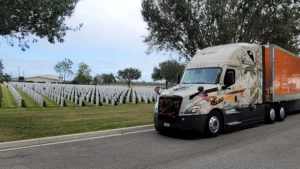WASHINGTON — A new report submitted by U.S. Transportation Secretary Pete Buttigieg to Congress analyzes the cost and effectiveness of electronic logging devices (ELDs) in commercial motor vehicles.
The report, which is mandated by law, also notes the difficulty in providing data on just how much safer ELDs have made the trucking industry — or whether they have had any real impact on safety at all.
“Since the full implementation of the ELD rule, multiple events have occurred that have impacted the use of ELDs, safety and hours of service (HOS) enforcement,” the report states. “Such factors include the September 2020 implementation of new HOS regulations, HOS exemptions issued in response to the COVID-19 pandemic (which suspended HOS rules for carriers transporting specified commodities in support of relief efforts during the pandemic) and the implementation of the Federal Motor Carrier Safety Administration’s (FMCSA’s) Drug and Alcohol Clearinghouse. These confounding factors have increased the challenges relating to any further analysis of the ELD mandate, making it difficult to tease out their individual safety impacts.”
In evaluating safety effects, the report notes that the FMCSA performed several types of analysis and used its judgment to select a conservative result for the number of crashes and fatalities avoided by ELD use.
“Using the elements of the Office of Management and Budget approved Information Collection Request for the paper records of duty status, the paperwork savings (driver time to prepare the paper records, clerical time to file and maintain the paper records and supporting documents for at least six months from the date the records are generated, and paper costs) and safety (crash reductions), the Regulatory Impact Analysis estimated the total annualized industry cost, using 2013 dollars and a 7% discount, to be $1.836 million, with annualized total benefits of $3.010 million, resulting in net benefits of $1.174 million,” the report states.
To evaluate compliance with the ELD rule, FMCSA analyzed the HOS violations that encompass the 10/11-hour driving time limits for buses and trucks, respectively; the 14/15-hour driving window or on-duty limits for trucks and buses; and the 60/70-hour weekly on-duty limits.
During the two-year period from the compliance date, Dec. 18, 2017, to the full compliance phase, which began Dec. 17, 2019, compliance with the HOS categories listed above improved, according to the report.
In December 2017, 1.19% of driver inspections cited at least one HOS violation.
“In December 2021, that percentage decreased to approximately 0.77. Increased compliance with the HOS rules reduces the risks of fatigue-related crashes attributable, in whole or in part, to patterns of violations of the HOS rules,” according to the report.
The report also notes that the transition to ELDs has increased the efficiency and effectiveness of FMCSA’s enforcement personnel and State Partners. ELDs improve the efficiency of investigations by allowing motor carriers to upload requested records for review by safety officials quickly and efficiently during roadside inspections, and also in advance of an investigation.
“By creating a standardized display in the Electronic Records of Duty Status software, safety officials can easily review logs, without having to decipher hand-written and hand-drawn records,” the report states. “In addition, ELDs make it easier for FMCSA and its enforcement partners to identify falsified records and take appropriate action. Due to the efficiency of using ELDs to review HOS, safety officials spend less time reviewing RODS, freeing them up to focus on other safety and enforcement matters.”
Click here to view the full report.
The Trucker News Staff produces engaging content for not only TheTrucker.com, but also The Trucker Newspaper, which has been serving the trucking industry for more than 30 years. With a focus on drivers, the Trucker News Staff aims to provide relevant, objective content pertaining to the trucking segment of the transportation industry. The Trucker News Staff is based in Little Rock, Arkansas.
















ELD logging has made to where you have to fight the clock and put stress factors on the drivers today, when your in a 5 to 6 mile back up and miles of road construction, no matter what you try to do the clock on the ELD is steadily counting down your driving time. There needs to be a better way the FMCA to figure to help drivers with the drive time. I have been a driver for 40 years, and I have not seen the FMCA help drivers but work against the driver. We as drivers work for pennies a mile an steadily under paid. The parking for drivers is almost nonexistent:
We where told ELDs would make the roads safer and ease congestion on the roads. So it appears the ATA was wrong? Go figure…
my opinion I think it’s all about making money we as truck drivers need to stop buying boats cars motorcycles and other materials that we don’t need for a moment they give you the credit cards for this then they say this is how we got you locked in that way you guys need to pay all this we need to stop and think for a moment if we can all agree like they did it Washington DC then we can make an impact in this American Way by not driving for a couple of days and then they will reach out for us or hear us and then we can make a decision on how much we should be making it’s like a strike but if Nobody Does it they found out a way to weaken us which is credit cards so we need to be together and fight back like they did in Washington DC a couple of weeks ago but if we stop driving we’ll make an impact and if we stop buying and saving money then we can all fight together and just go down there put our trucks down there and don’t even move it until they can hear us that’s what I think the same way they do in the Latin areas out there in the islands they stopped their trucks and they get their way and they increase their pay why can’t we do it here in the United States that’s what I think